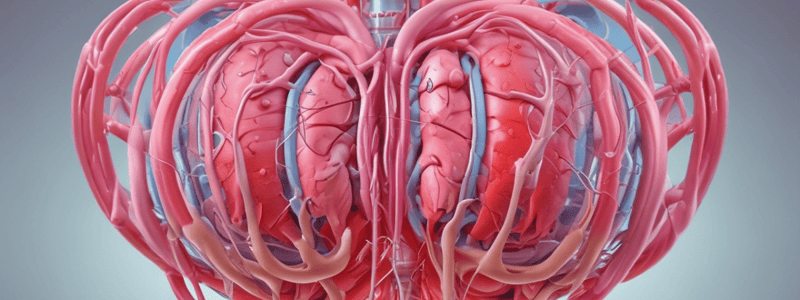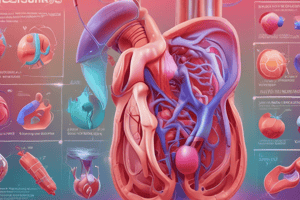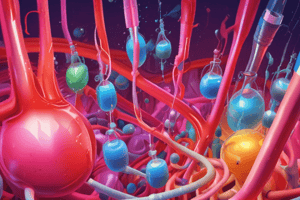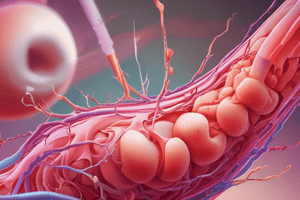Podcast
Questions and Answers
Bronchodilators primarily work by decreasing edema and inflammation in the airways.
Bronchodilators primarily work by decreasing edema and inflammation in the airways.
False (B)
Anti-inflammatories can be given only orally to treat respiratory conditions.
Anti-inflammatories can be given only orally to treat respiratory conditions.
False (B)
Expectorants make mucus thicker and harder to expectorate.
Expectorants make mucus thicker and harder to expectorate.
False (B)
Pursed-lip breathing involves exhaling through the mouth slowly and rapidly to improve lung function.
Pursed-lip breathing involves exhaling through the mouth slowly and rapidly to improve lung function.
Incentive spirometers should be held or placed in a reclined position for optimal use.
Incentive spirometers should be held or placed in a reclined position for optimal use.
Sputum and throat culture specimens are diagnostic tests used to assess oxygenation.
Sputum and throat culture specimens are diagnostic tests used to assess oxygenation.
Arterial blood gases measure the volume and capacity of the lungs.
Arterial blood gases measure the volume and capacity of the lungs.
Pulmonary function tests can reveal an enlarged heart on a chest X-ray.
Pulmonary function tests can reveal an enlarged heart on a chest X-ray.
Bronchoscopy is a procedure that allows a physician to visually inspect the patient's airways.
Bronchoscopy is a procedure that allows a physician to visually inspect the patient's airways.
Computerized tomography (CT) scans expose patients to radiation.
Computerized tomography (CT) scans expose patients to radiation.
Magnetic resonance imaging (MRI) procedures use a strong magnetic field to create images, but there is no exposure to radiation.
Magnetic resonance imaging (MRI) procedures use a strong magnetic field to create images, but there is no exposure to radiation.
A ventilation/perfusion (V/Q) scan is a type of lung imaging that uses radioactive tracers to assess lung function.
A ventilation/perfusion (V/Q) scan is a type of lung imaging that uses radioactive tracers to assess lung function.
A D-dimer test is used to detect the presence of blood clots in the body.
A D-dimer test is used to detect the presence of blood clots in the body.
Thoracentesis is a procedure where fluid is removed from the pleural cavity to relieve breathing difficulties.
Thoracentesis is a procedure where fluid is removed from the pleural cavity to relieve breathing difficulties.
Arterial blood gases (ABGs) are used to evaluate venous blood oxygenation and acid-base balance.
Arterial blood gases (ABGs) are used to evaluate venous blood oxygenation and acid-base balance.
An electrocardiogram (ECG) is an invasive test that visualizes the heart's structures using ultrasound waves.
An electrocardiogram (ECG) is an invasive test that visualizes the heart's structures using ultrasound waves.
Thoracentesis can be used to introduce chemotherapeutic drugs into the pleural cavity.
Thoracentesis can be used to introduce chemotherapeutic drugs into the pleural cavity.
Sputum and throat culture specimens are used to assess for adventitious breath sounds.
Sputum and throat culture specimens are used to assess for adventitious breath sounds.
During a bronchoscopy, a transducer is used to visualize the heart's structures by reflecting ultrasound waves.
During a bronchoscopy, a transducer is used to visualize the heart's structures by reflecting ultrasound waves.
Mucous membranes become wetter and stronger with age.
Mucous membranes become wetter and stronger with age.
Hypoxemia is caused by excessive oxygen levels in the blood.
Hypoxemia is caused by excessive oxygen levels in the blood.
Ischemia is characterized by an excessive amount of blood supply to tissues.
Ischemia is characterized by an excessive amount of blood supply to tissues.
Bronchospasm can be caused by the aspiration of stomach contents into the lungs.
Bronchospasm can be caused by the aspiration of stomach contents into the lungs.
Anemia is a condition where the blood has an enhanced ability to carry oxygen.
Anemia is a condition where the blood has an enhanced ability to carry oxygen.
A volume-oriented device requires more effort to raise the balls or disks than a tilted flow-oriented device.
A volume-oriented device requires more effort to raise the balls or disks than a tilted flow-oriented device.
For a flow-oriented device, it is recommended to take brisk, low-volume breaths to snap the balls to the top of the chamber.
For a flow-oriented device, it is recommended to take brisk, low-volume breaths to snap the balls to the top of the chamber.
Sustained elevation of the balls or cylinder during spirometry ensures adequate ventilation of the alveoli.
Sustained elevation of the balls or cylinder during spirometry ensures adequate ventilation of the alveoli.
Using a nose clip while using an incentive spirometer can help if you have difficulty breathing only through the nose.
Using a nose clip while using an incentive spirometer can help if you have difficulty breathing only through the nose.
Supplemental oxygenation is considered a medication because it involves administering a substance to support respiratory function.
Supplemental oxygenation is considered a medication because it involves administering a substance to support respiratory function.
The maximum flow rate administered via a nasal cannula is 10 L/min.
The maximum flow rate administered via a nasal cannula is 10 L/min.
Sputum cultures are used to identify the presence and type of microorganisms in the lower respiratory tract.
Sputum cultures are used to identify the presence and type of microorganisms in the lower respiratory tract.
Arterial blood gases measure the oxygen and carbon dioxide levels in the venous blood.
Arterial blood gases measure the oxygen and carbon dioxide levels in the venous blood.
Pulmonary function tests, such as spirometry, can be used to diagnose lung diseases like asthma and COPD.
Pulmonary function tests, such as spirometry, can be used to diagnose lung diseases like asthma and COPD.
Chest x-rays can detect the presence of lung tumors or abscesses.
Chest x-rays can detect the presence of lung tumors or abscesses.
Lung scans, such as ventilation/perfusion (V/Q) scans, are used to assess the ventilation and perfusion of the lungs.
Lung scans, such as ventilation/perfusion (V/Q) scans, are used to assess the ventilation and perfusion of the lungs.
Bronchoscopy is a procedure that uses a small camera to examine the upper respiratory tract.
Bronchoscopy is a procedure that uses a small camera to examine the upper respiratory tract.
Throat cultures are used to identify the presence of microorganisms in the upper respiratory tract.
Throat cultures are used to identify the presence of microorganisms in the upper respiratory tract.
Lung function tests can be used to determine the severity of lung disease and guide treatment.
Lung function tests can be used to determine the severity of lung disease and guide treatment.
Chest x-rays can detect the presence of air leaks in the lungs.
Chest x-rays can detect the presence of air leaks in the lungs.
Flashcards are hidden until you start studying




